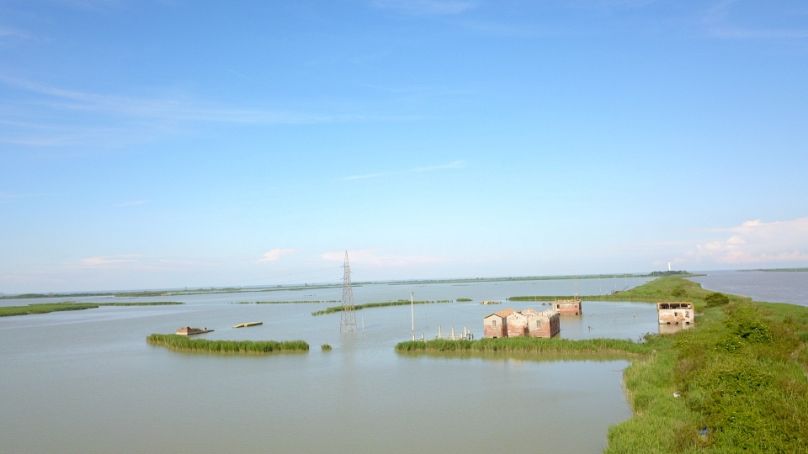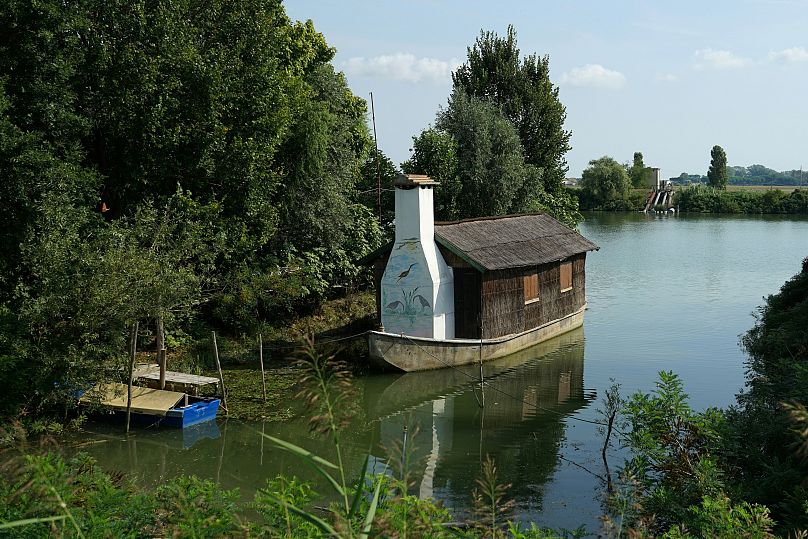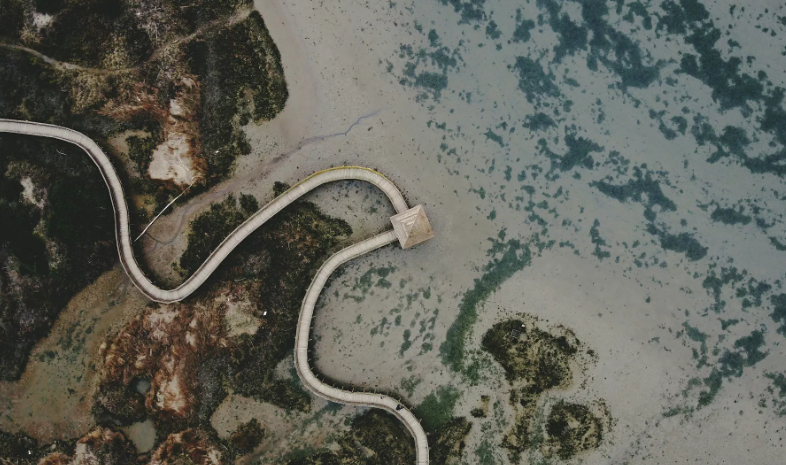The Po Delta is also having to brace against a barrage of problematic, climate change-induced conditions.
The Po Delta covers an area of around 500 km2 in northeast Italy. Located around an hour south of Venice, the wetlands veined with rivers are some of the largest and richest in the Mediterranean.
Partly created by slow sedimentation and partly by human reclamation efforts, the park is a complex mosaic of lagoons, marshes, beaches and farmland.
However, the UNESCO-designated biosphere reserve is engaged in a long-standing battle against the encroaching Adriatic Sea.
Now, a reignited project to drill for gas offshore is prompting fresh fears of flooding.
Italy’s UNESCO-designated delta is sinking
At the mouth of the Po Delta, where the land is dispersed within a labyrinth of canals and lagoons, a crumbling brick warehouse lies semi-submerged by water. The building was once located on Batteria island along with a scattering of houses.
In the mid-20th century, water began to lap over the island’s shores. It wasn’t caused by sea level rise but by the land sinking. Residents tried to take advantage of the abundance of water by cultivating rice paddies, but by the 1970s, Batteria had to be abandoned to the sea.
The island’s settlement, though begun earlier, was aggravated by the extraction of gas in the delta that took place between the 1930s and 1960s. The process meant drawing gas and salt water from beneath the ground, causing the already unstable land to sink faster.
Several other areas of land around the edge of the delta also disappeared underwater.
By 1959, there were 1,424 wells extracting as much as 300 million cubic metres of gas a year. After a government investigation found drilling was causing land sinkage, extraction activity was halted in 1965.
From the end of the 18th century to today, some areas of land in the Po Delta have shrunk to four metres below sea level, according to the director of the Po Delta reclamation consortium Giancarlo Mantovani.
Some of the causes are natural, but they account for a fraction of the settlement. An accumulation of sediment brought by rivers causes soil to compact and sink but only around one or two millimetres per year.

Reclamation also has an impact but with a maximum subsidence of around 70 centimetres annually.
“The real problem was created with the extraction of methane, » Mantovani told Italian newspaper l’Internazionale.
The land level has continued to drop because « what was set in motion is not an engine that turns on and off as you want, » he added.
Now, it is a constant fight to keep the water at bay using drainage pumps and hydraulic defences. High embankments line the tributaries of the Po River. Standing on the road on top, you can see how the water is often significantly higher than the land.
Italy’s biggest delta is battling against climate change
The Po Delta is also having to brace against a barrage of problematic, climate change-induced conditions.
For several years now, the area has suffered prolonged drought. This is then followed by torrential downpours that release months-worth of rain in a matter of hours, which the sun-hardened ground cannot absorb.
Lack of glacial water coming down from the mountains and sea level rise means the freshwater of the rivers is being contaminated by salt sucked upstream from the sea.
« Certainly, what we are witnessing is the outcome of the ongoing climate changes, which are already underway, » Ramona Magno, a drought and desertification expert at Italy’s National Research Council, told FairPlanet.
These conditions are destroying the delta’s rich biodiversity and fragile habitats. It is home to over 350 bird species and more than 1,000 plant species.
Birds like herons, flamingoes and snowy egrets crowd the marshland while the varied landscape includes ancient forests, giant sand dunes and a maritime pine-filled botanical garden.
But there are already signs of change. The saline water is wiping out areas of forest where dead trees now protrude from stagnant lagoons.
The Po Delta is also a prime area for agriculture, with acres of rice paddies and maize plantations, but the high concentration of salt in the water is also causing irrigation problems.

At the mouth of the delta, an area known as the Sacca di Scardovari is home to a clam and mussel fishing community.
The shoreline is dotted with wooden huts on stilts where the crustaceans are collected and processed.
But warming waters mean the livelihood of these fishermen is at risk. Rising temperatures are altering the marine environment causing a boom in blue crab numbers. This non-native species feeds on clams and mussels and has decimated their populations.
We explored this in detail last year in our piece on how blue crabs were threatening Italy’s fishing industry.
Italy’s Po Delta is in danger again from offshore drilling
Despite all the risks already facing the fragile Po Delta, another is looming.
Now, as the Ukraine war has curtailed supplies of gas, the Italian government has given the green light for the resumption of drilling in the upper Adriatic.
It comes despite repeated warnings of the risks of environmental damage.
“We have tried to raise everyone’s awareness of concrete issues such as the increase in salt which damages agriculture,” Vanni Destro, spokesperson for the Polesine No Drills Committee, told l’Internazionale.
“But sometimes we even lack the memory of what has already happened. And therefore many become alarmed only if it is pointed out to them that Venice could also sink due to subsidence.”
While the drilling that ended in the 60s occurred on land, the new wells will be located offshore. This reduces the risk of subsidence, but they are still close enough to have an effect, experts say.
“We are already overwhelmed by the blue crab, now the drills: we risk definitive collapse,” said Roberto Pizzoli, the mayor of the delta town of Porto Tolle.
For many environmental groups and local politicians, the dangers far outweigh the possible benefits. The drilling would extract at most 10 billion cubic metres of gas in 16 years, a fraction of Italy’s annual consumption of 70 billion cubic metres.
“The drilling would be irrelevant for our energy needs, but have a considerable impact on the environment,” the Veneto region’s president Luca Zaia told media.
“The topic of drilling comes up cyclically, and the delta increasingly shows itself to be a delicate and fragile territory that requires protection,” said Luisa Beltrame, the mayor of the delta town of Ariano del Polesine.
“We need certainties and guarantees to safeguard the future of this environment and the liveability of our communities who are already suffering from other emergencies.”




